CDCA5 Polyklonaler Antikörper
CDCA5 Polyklonal Antikörper für WB, ELISA
Wirt / Isotyp
Kaninchen / IgG
Getestete Reaktivität
human
Anwendung
WB, ELISA
Konjugation
Unkonjugiert
Kat-Nr. : 29316-1-AP
Synonyme
Galerie der Validierungsdaten
Geprüfte Anwendungen
| Erfolgreiche Detektion in WB | HeLa-Zellen, K-562-Zellen, LNCaP-Zellen, U2OS-Zellen |
Empfohlene Verdünnung
| Anwendung | Verdünnung |
|---|---|
| Western Blot (WB) | WB : 1:2000-1:12000 |
| It is recommended that this reagent should be titrated in each testing system to obtain optimal results. | |
| Sample-dependent, check data in validation data gallery | |
Produktinformation
29316-1-AP bindet in WB, ELISA CDCA5 und zeigt Reaktivität mit human
| Getestete Reaktivität | human |
| Wirt / Isotyp | Kaninchen / IgG |
| Klonalität | Polyklonal |
| Typ | Antikörper |
| Immunogen | CDCA5 fusion protein Ag30966 |
| Vollständiger Name | cell division cycle associated 5 |
| Berechnetes Molekulargewicht | 27 kDa |
| Beobachtetes Molekulargewicht | 27~35 kDa |
| GenBank-Zugangsnummer | BC011000 |
| Gene symbol | CDCA5 |
| Gene ID (NCBI) | 113130 |
| Konjugation | Unkonjugiert |
| Form | Liquid |
| Reinigungsmethode | Antigen-Affinitätsreinigung |
| Lagerungspuffer | PBS mit 0.02% Natriumazid und 50% Glycerin pH 7.3. |
| Lagerungsbedingungen | Bei -20°C lagern. Nach dem Versand ein Jahr lang stabil Aliquotieren ist bei -20oC Lagerung nicht notwendig. 20ul Größen enthalten 0,1% BSA. |
Hintergrundinformationen
Human cell division cycle associated 5 (CDCA5), also known as Sororin, is required for stable binding of cohesin to chromatid in the S and G2/M phases and degraded through anaphase-promoting complex-dependent ubiquitination in the G0/G1 phase (PMID: 30808873). Suppression of CDCA5 expression with siRNAs inhibited the growth of lung cancer cells. CDCA5 positivity is an independent prognostic factor for lung cancer patients (PMID: 20551060). The predicted molecular size of CDCA is 27 kd, with an electrophoretic mobility of ~35 kd on SDS-PAGE, possibly due to its isoelectric point (pI) of approximately 10 (PMID: 22580470).
Protokolle
| Produktspezifische Protokolle | |
|---|---|
| WB protocol for CDCA5 antibody 29316-1-AP | Protokoll herunterladen |
| Standard-Protokolle | |
|---|---|
| Klicken Sie hier, um unsere Standardprotokolle anzuzeigen |


